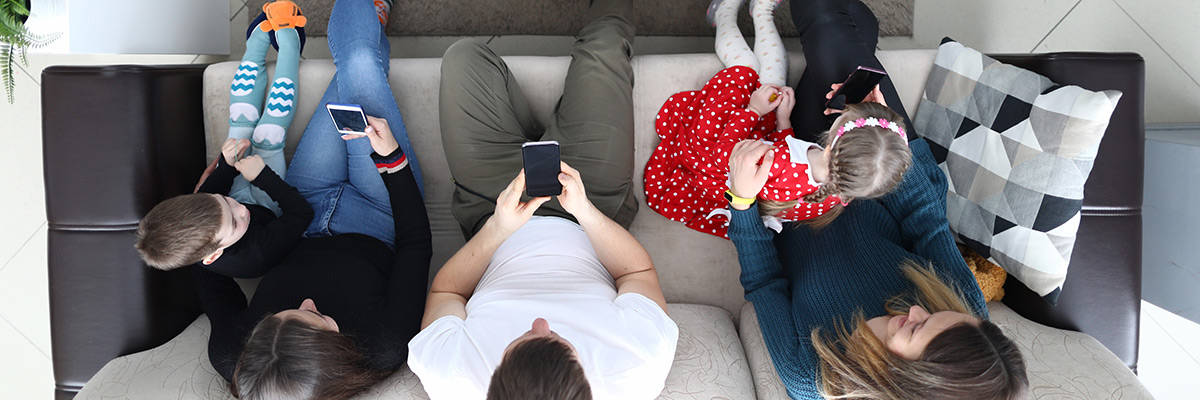
Screen Time Guidelines for All Ages
We live in a tech-centric world. As a result, it is becoming harder and harder to go about our daily tasks without looking at a screen.
For example, you send messages and communicate using your mobile phone, you do most of your work or school on your computer, and then spend time on your phone, tablet, or computer to unwind.
Technology can be great when we use it to complete tasks, communicate, or for leisure. It can aid us greatly in several aspects. However, as with most things in life, too much of something is never good.
Negative effects of excessive screen use include sleeping problems, behavior and educational problems, obesity, and trouble concentrating. People of all ages (including the youngest) are affected and need limits regarding screen use.
That’s why we’ve prepared screen time guidelines by age. Our recommendations will equip you to manage screen time use in your family.
How to Define Screen Time
When evaluating your family’s screen time, you’ll have to consider that not all of the screen usage will be negative, and some of it will be necessary.
In general, we split screen time usage into two main categories:
- Active – this is the time we spend using our screens to learn, do creative tasks, video calls, or tasks that involve using our brains extensively. This type of screen time can be highly productive and can replace some of the previously done activities without screens.
- Passive – passive screen time is “vegetative” time in front of our screens. It’s the absent-minded scrolling on social media or Google, watching videos on YouTube, playing repetitive games, binge-watching shows on Netflix, and so on. It’s the low-effort type of screen usage that doesn’t benefit our brains.
When it comes to screen time guidelines, the most important thing is to have a healthy balance between active and passive screen time. Ideally, active screen time should be a priority over passive screen time.
Suppose you’re finding it tough to cut down on your child’s time using screens. In that case, a good tip is to encourage them to do more active tasks using their screens, such as learning new things such as a new language, watching educational videos, or completing activities that involve creativity and thinking. They could also socialize with friends through video calls.
Screen Time Guidelines by Age

Here are the screen time recommendations by age chart.
Limiting screen time should start early in your child’s development. In early childhood, a child’s brain is rapidly changing. So pay close attention to how much screen time you are providing your child.
For children up to 6, you must teach them about mindful technology use as a parent. Start this education early, including teaching them about the dangers of excessive screen use and how to keep a balance. As a family, you should have reasonable screen time limits.
According to the American Academy of Pediatrics (AAP), these are the following screen time guidelines for children:
- Age 2 and under – avoid media use, except for video calls. Early childhood is an important time for ensuring that your child grows up into a healthy child later on. Their brain structure is changing rapidly, and using too much technology can have adverse effects later on. That’s why minimal to no screen time is recommended for this group age, except for video calls.
- Age 2 to 5 – one hour or less of active screen time. Ensure that your child gets quality, active screen time and little-to-no passive screen time at this stage. Also, limit screen use to one hour at most and ideally not at the same time.
- Age 6 to 12 – limit screen use to a healthy amount, no more than two hours of screen time at most. Establish positive habits and encourage active screen time. Adequate sleep time (8-12 hours), unplugged downtime, and activities that involve socialization should be encouraged.
- Teens – limits should be set up for passive screen time such as playing games, social media use, and watching videos repeatedly. As a parent, you need to make sure that your teen(s) are physically active and do other activities offline, especially social activities. Here is a list of 50 screen-free activities.
- Adults – less than two hours of screen time for recreation. The more you use screens for work, the less you want to use them for entertainment.
Remember, these are rough guidelines that you should prioritize at an early age. As your child grows older, it will be harder to control media use. You’ll need to set up routines and strict rules for screen use and encourage a healthy lifestyle.
Screen Time Guidelines for Teens

The statistics about the screen time use of teens in the US are alarming. On average, teens spend around 9 hours a day on their screens for entertainment, which is well over the recommended limit of about 2 hours of screen use for entertainment, excluding school use.
The amount of screen use has also been increased due to the pandemic when social interaction possibilities and other types of leisure were limited. In addition, teens, and children, were forced to do school from home, increasing the amount of screen time required every day. As a result, maintaining screen time balance became harder.
To avoid adverse effects associated with excessive screen time, develop screen time limits in your household. These limits should include where, when, and how much screen time is allowed, including reasonable limits on passive screen time, such as video games or YouTube watching.
Additionally, it’s crucial to monitor screen use for school or homework and ensure during that time, no other types of on-screen activities are occurring.
Screen Time Guidelines for Adults

The screen time recommendation for adults is two hours for entertainment and leisure activities, such as watching videos, social media use, and other passive screen time activities.
This recommendation excludes the time you spend on your screen for work or school. In the UK, the average screen time for adults is around 6 hours and 30 minutes, which is also consistent for the US and the rest of the developed world.
Weekly, this translates to around 45 hours per week. Of course, we have to consider that many people use their screens for work, leading to more hours of screen time use.
However, most people included in the survey report using their screens (mobile, laptops, tablets) for entertainment, which means there are more opportunities to reduce screen time than people may think.
Excessive screen time will also have adverse effects for adults, just like it does for children and adults. For example, it can result in obesity, eyesight problems, sleeping problems, anxiety, depression, neck and back problems, and more.
But perhaps even more importantly, if you use your screen excessively as a parent, it will also impact your child’s screen use. Research shows excessive screen time use in parents drastically increases the likelihood their children will use their screens excessively.
As a parent, you set the example for your child, even when it comes to screen time. If you spend too much time with your screen, your child will see it as something normal, resulting in excessive screen time use in children.
If you’re a parent who wants to reduce the time your child spends on their screens, then you’ll need to address your screen time use first.
You’ll need to set a good example for your child and set expectations on balancing their screen use. For instance, encourage healthy, physical activities and diet, enough sleep, and active types of screen use that we’ve discussed above.
Screen Time Guidelines During Covid-19

During Covid-19, the recommended screen time for entertainment is two hours at most.
Covid-19 has increased screen use among people of all ages, including adults. For example, 44% of parents of children of all ages report that their child has spent more than four hours of their time on their screens, which is significantly more than they did before the pandemic.
But too much screen time has also become a problem for adults during Covid-19. Many people work from home – up to 30% more than before the pandemic. And when we work from home, it gets increasingly harder to control our screen time. Switching from your work to check social media or news is easier than it is at work, which can make you less productive and increase your screen time significantly.
So, how can we combat the excess screen time during Covid-19?
- Set up a working schedule. When you work, set boundaries and limits to avoid distractions, such as social media, video games, or other types of passive screen use.
- Put away your phone. It can be a good idea to have your phone far away in another room while you work, or even have it turned off.
- Take short breaks. If you’re finding it hard to concentrate and your mind seems to wander away as you work, set up short five-minute breaks every 30-50 minutes to improve your focus.
- Accept that you’re going to have to use technology. If you’re working from home, you’re going to have to use your screen for work. Just make sure you get the most out of it as possible.
How Much Screen Time is Too Much?
It’s hard to give a straightforward answer on how much screen time is too much for adults; the only clear way to observe this is to watch the effects of screen time on you and your health.
Excess screen time (six hours and more) puts you at a higher risk of depression, this study finds. On the other side of the spectrum, limiting social media use to only 30 minutes per day can decrease loneliness and depression.
An excellent way to find a balance between quality screen time and passive screen time is to listen to your body; is too much screen time affecting you negatively regarding your mental and physical health? Some of the most common negative effects of excessive screen time include:
- Anxiety
- Depression
- Loneliness
- Insomnia and poor sleeping habits
- Eye strain and headaches
- Neck and back pain
- Reduced physical activity levels and obesity
- Addictive behaviors (video games, gambling)
Aim for less than two hours of entertainment using your devices. This limit can be beneficial if you do your work on your computer, which is when you’ll want to limit the time you spend on your screen passively and increase the time you spend using your screen actively, such as for work.
How to Limit Screen Time?
Limiting screen time is essential. It is crucial to avoid gaming addiction, depression, anxiety, poor sleep habits, and other adverse effects connected to excessive screen use.
Whether it’s for you or your child, there are specific measures you can take to decrease the time you spend on your screen. Remember the earlier you start implementing these measures, the more likely you will avoid problems associated with excessive screen time or poor screen time habits later in a child’s development.
- Set up rules for screen time use in your home. You’ll need to define when, where, and how screens are allowed. For example, you could set up a rule to disallow screen use during meals, such as dinner or lunch.
- Limit activities that involve using a screen. Make sure you and your child limit activities that include screens unless they are essential. You’ll want to replace these activities with other activities that promote physical and mental health. For example, provide physical copies of books for your child instead of using digital ones.
- Promote active screen use and limit passive use. Begin by replacing passive activities on the phone, such as social media use or watching videos, with active learning and creative activities.
- Teach your child early. You have to accept that some technology will always be present, and you can’t get away from it. Instead, provide early education about managing technology and screen time. Teach your child that phones and tablets are not toys and should be used with intention.
- Ensure you or your child gets enough sleep. Sleeping habits often get compromised because of excess screen time. Make sure that you get 7-8 hours of sleep every day and that your child also gets 8-12 hours of sleep at least. It can be helpful to have screen time limits, such as no screen time two hours before bedtime and no phones in their bedroom.
- Encourage physical world friendships and social activities. Another important aspect of limiting screen use will be to promote social activities that involve seeing friends in physical life, not just through screens. While video chats can help foster new friendships, we still need a level of physical connection with other people.
- Stay on top of trends. New apps are coming out all the time, whether it’s TikTok, Snapchat, Instagram, or others. Be aware of which apps are popular and which apps are dangerous which encourage your child to spend more time on screens than they should.
Find help. If you need assistance, it can be helpful to speak with a therapist or licensed professional who specializes in gaming and screen time issues. Alternatively, try our Reclaim program for families, where we help your family manage excessive gaming and screen time, including setting up a Family Screen Time Agreement.
